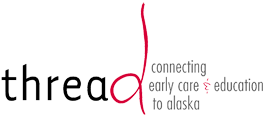Talking Points for thread’s 2024 Legislative Policy Ask
As child care businesses continue to close, staff turnover remains high, and the cost of care for families grows, sustainable state funding for the child care sector in Alaska is desperately needed. That’s why thread, along with our partners at the Alaska Early Childhood Advocacy Group (AECAG) have come together to ask the Alaska Legislature for a $30.5 million dollar increase to the operating budget Child Care Benefits line item. This money will got to support child care programs, early educators, and families across Alaska. Please consider the talking points below and send a message to Senators on the Finance Committee encouraging support for an additional state investment to our struggling child care system.
Providers/Workforce: $8M
$7M would provide the System for Early Education Development (SEED) with resources to continue an annual early educator wage stipend, ROOTS (Retaining Our Outstanding Teachers Stipends).
- Early educators are paid on average $29,500/year or $ 14 /hour, less than a gas station attendant.
- Most early educators do not receive paid benefits from their employer
- Low wages create high competition for recruiting and retaining staff
- Low wages create an industry with high turnover (near 50%), which leads to disruptions in care and lower quality program experiences for young children and their families.
- Wage stipends are found to incentivize and provide positive reinforcement for early educators
- Wage stipends are found to help early educators cover basic expenses like transportation to get to work.
- Wage stipends are found to help early educators invest in their health including going to the doctor or dentist when typically they are unable to afford it.
- Consistent and reliable wage stipends are important to retain and support this critical sector.
$750K would allow thread to expand teacher wellness supports including offering access to tele-health and tele-mental health services.
- Child care is an intensive job demanding physical movement, emotional balance and mental focus.
- Focus on wellness is important for early educators as they are stressed, burned out and overall an exhausted workforce.
- Providing benefits and wellness supports demonstrate the importance of self care and wellness to ensure our educators are showing up healthy and ready for the care and education of our youngest children.
$250K for continuation of low-cost access to professional development training and supports, including small business/management resources, through thread.
- The Governor’s child care task force recommends continued investment in workforce supports that have proven successful and reported as helpful by early educators. This includes continuing investments in low-cost access to professional development training and small business resources.
- Early educators can build their skills, knowledge and early childhood competencies through affordable professional development training.
- Early educators will have access to resources developed by the Alaska Small Business Development Center specifically designed to support child care business development, management and HR skills.
Alaskan Families
$7M for increasing access to Child Care Assistance for eligible families. This could include free child care assistance for early educators, increased eligibility for families, waved copays or tiered assistance payments based on program quality or type of care.
- Child care is expensive for every family. It is even more so, for low/middle income families.
- On average, families spend 15%-35% of their income on child care.
- More access to affordable care and education options are needed. Currently fewer than 1,700 families utilize the Child Care Assistance program.
- 60% of families say that cost is their biggest barrier to finding child care.
- More than 25,000 Alaskan adults could enter the workforce or take on more hours if they had access to affordable and quality child care.
- Child care assistance is not accessible/affordable for most families. Expanding the eligibility of families would allow more to access the benefit and ensure their children can access quality child care.
- Eliminating the copay requirements for families demonstrated success in family support during the pandemic. thread recommends increasing the Child Care Assistance investment to allow for covering co-payments for participating families.
- The Governor’s child care task force recommends free child care for early educators as a way to recruit and retain more early educators. thread supports this expansion of child care assistance eligibility and access.
- Many states offer tiered child care assistance benefits. This would allow for more lower income families to have more access to high quality care. Additionally, tiered reimbursement can provide weighted supports for more expensive care, such as infant/toddler care, to ensure programs are paid closer to the true cost of care provided.
(Note: Current investment in child care: $30,508,565. This includes: $27,241,144 federal + $3,267,421 SOA required maintenance of effort)


